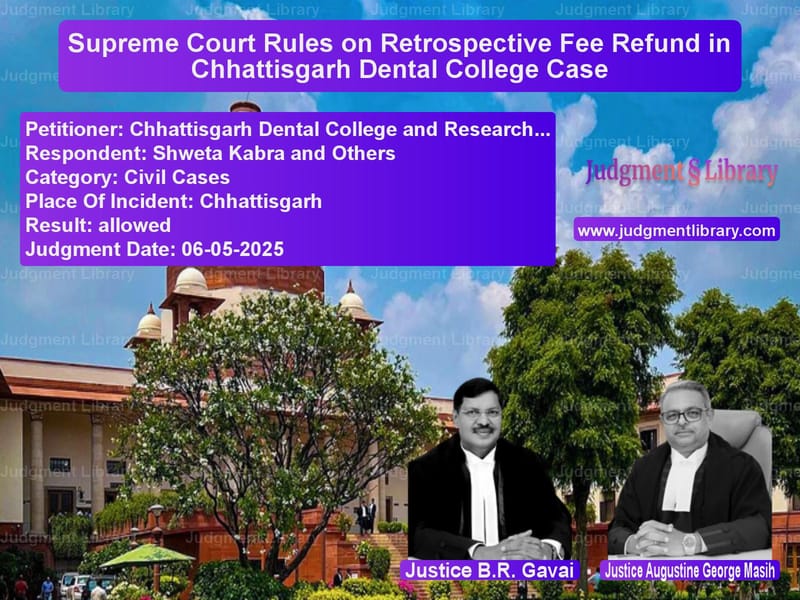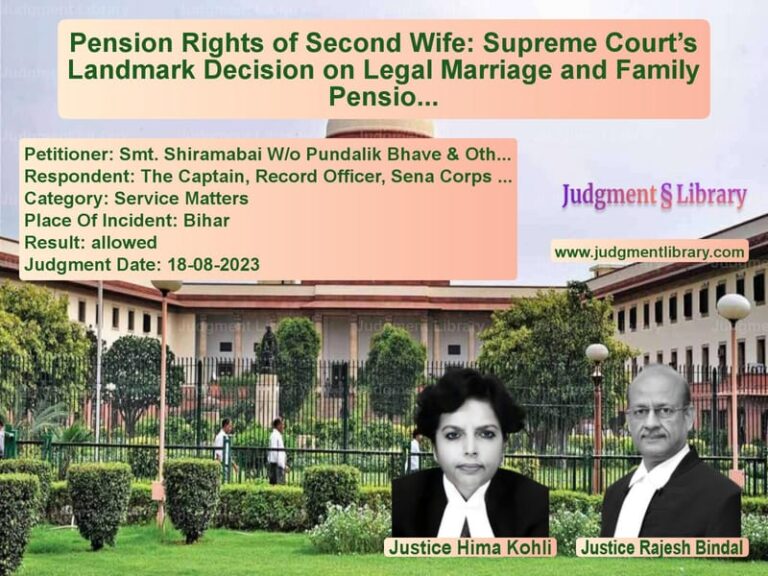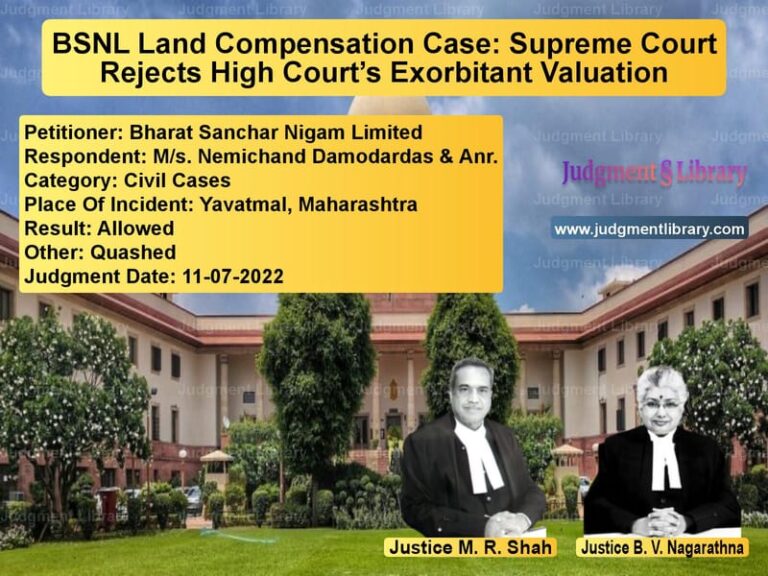Supreme Court Rules on Retrospective Fee Refund in Chhattisgarh Dental College Case
The corridors of India’s highest court recently echoed with a significant decision concerning the contentious issue of fee regulation in private educational institutions. The case of Chhattisgarh Dental College and Research Institute versus Shweta Kabra and Others represents a crucial chapter in the ongoing dialogue between educational autonomy and regulatory oversight. This legal battle, which spanned nearly two decades, culminated in a judgment that clarifies the important principle of retrospectivity in fee fixation matters.
The story begins in the early 2000s when Chhattisgarh Dental College and Research Institute was established after receiving formal permission from the Ministry of Health and Family Welfare in February 2002. Like many private professional colleges across India, the institution set its own fee structure, determining that general category students would pay Rs. 2,12,500 as tuition fee plus Rs. 12,500 as caution fee, while reserved category students from SC/ST/OBC backgrounds would pay Rs. 1,12,500 as tuition fee plus the same caution fee amount. Based on this published fee structure, the college admitted students for the academic years 2003-2004 and 2004-2005, collecting fees according to these predetermined rates.
The landscape of educational fee regulation underwent a seismic shift in August 2003 when the Supreme Court, in the landmark case of Islamic Academy of Education and Another v. State of Karnataka and Others, directed that every state must constitute a committee specifically for the purpose of fee fixation in private educational institutions. This judgment emerged from the court’s growing concern about profiteering and commercialization in education, particularly in professional courses like medicine and dentistry where seats are limited and demand is high.
In compliance with this directive, the State of Chhattisgarh constituted the Justice S.D. Jha Committee, commonly referred to as the Fee Fixation Committee. The formation of this committee marked the beginning of the regulatory oversight that would eventually lead to the legal dispute at hand. The committee’s deliberations, however, were not without their challenges. Records indicate that there were differences of opinion between the chairman and other members of the committee, reflecting the complex nature of balancing institutional needs with student interests.
After due consideration, the Fee Fixation Committee determined that the appropriate fee structure for Chhattisgarh Dental College should be Rs. 1,25,000 per year. Crucially, the committee made it explicitly clear that this fee would be effective from the academic year 2005-2006 onward and would remain valid for three years, until the academic year 2007-2008. The State Government formalized this decision through a letter dated July 25, 2005, communicating the fixed fee to the appellant-college.
Dissatisfied with this determination, the college approached the Chhattisgarh High Court through a writ petition (W.P. No. 3628/2005), challenging the fee fixation on the grounds that it was done without proper consideration of relevant material. The college argued that the committee had failed to account for the actual costs of running a dental college, including infrastructure maintenance, faculty salaries, equipment costs, and other operational expenses. Meanwhile, parallel developments were occurring as some students from the 2003-2004 batch filed their own writ petition (W.P. No. 5764/2005), seeking relief from what they perceived as excessively high fees compared to the newly fixed structure.
The High Court’s handling of these interconnected petitions created a complex legal scenario. In September 2005, the court directed the college to change its fee structure effective from the academic year 2005-2006, essentially upholding the Fee Fixation Committee’s determination. Subsequently, in November 2005, the High Court passed an order restraining the college from demanding fees in excess of the committee-fixed amount of Rs. 1,25,000. This order was later modified in January 2006, directing students to pay Rs. 1,50,000 as tuition fee as an interim arrangement pending the final outcome of the writ petitions.
The matter reached its climax at the High Court level through a common judgment and final order dated April 6, 2010. The High Court ruled that the fee of Rs. 1,25,000 per year per student would apply not only prospectively from 2005-2006 but also retrospectively to students admitted prior to that academic year. Furthermore, the court directed that any amount paid by students in excess of this fixed fee must be refunded by the college. This retrospective application of the fee structure formed the crux of the college’s grievance that would eventually bring the matter before the Supreme Court.
The appellant-college, through its learned counsel, presented a focused argument before the Supreme Court. Their primary contention was straightforward and legally precise: “the only grievance is that once the fee structure was determined by the Fee Fixation Committee which was from the academic year 2005-2006, the High Court could not have made the said fee structure applicable retrospectively thereby directing refund of excess fee.” This argument centered on the fundamental principle that regulatory decisions typically operate prospectively unless explicitly stated otherwise. The college maintained that since the Fee Fixation Committee had clearly specified that the new fee structure would be effective from 2005-2006 onward, applying it to previous academic years constituted an erroneous retrospective application that violated basic principles of administrative law.
The respondents, represented by students who had been admitted in the 2003-2004 and 2004-2005 batches, likely argued that justice demanded uniform fee application across batches, particularly when the committee had determined that Rs. 1,25,000 represented the appropriate fee for the education being provided. They might have contended that charging different fees for students receiving essentially the same education and facilities amounted to unfair discrimination. However, the Supreme Court judgment focuses primarily on the college’s arguments and the legal principle of retrospectivity.
The Supreme Court bench comprising Justice B.R. Gavai and Justice Augustine George Masih heard the arguments from both sides and examined the material on record. The court found substance in the submission made by the learned counsel for the appellant-college. In their analysis, the judges emphasized the explicit temporal limitation contained in the Fee Fixation Committee’s determination. The court noted: “Admittedly, it was only subsequent to the judgment of this Court in the case of Islamic Academy of Education (supra), the fee structure came to be determined and the Fee Fixation Committee directed that Rs.1,25,000/- would be applicable and that too only from the academic year 2005-2006 onwards.”
This observation highlights the court’s recognition that the very mechanism for fee fixation emerged from the Islamic Academy judgment, and therefore, the committee’s determination could only apply from the point of its establishment onward. The court further stated: “In that view of the matter, we are of the considered view that the High Court was not justified in directing the refund of excess fee to the students who were admitted prior to the academic year 2005-2006.” This clear articulation underscores the court’s position on the impermissibility of retrospective application unless specifically intended by the regulating authority.
The judgment also addressed the practical implications of its decision. During the pendency of the appeal, the Supreme Court had passed an interim order on May 12, 2010, directing the college to refund excess amounts to students who had approached the court while requiring those students to furnish bank guarantees against the refund amount for the release of their academic documents. Students who hadn’t paid any fee were directed to furnish bank guarantees of Rs. 1,00,000 for the release of their documents. Having ruled in favor of the college on the legal principle, the court now permitted the appellant-college to encash the bank guarantees executed by the students in terms of the earlier order.
This aspect of the judgment demonstrates the court’s understanding of the practical complexities involved in implementing legal decisions in educational matters. The bank guarantee mechanism had ensured that while students received immediate relief in terms of document access and potential refunds, the college’s financial interests were protected pending the final outcome of the legal proceedings. The court’s decision to allow encashment of these guarantees restored the financial position to what it would have been had the High Court not erroneously applied the fee structure retrospectively.
The Supreme Court’s ruling in this case represents an important precedent in the evolving jurisprudence around educational fee regulation. It reaffirms the principle that regulatory bodies must operate within their designated scope and that their decisions typically carry prospective effect unless explicitly stated otherwise. This approach provides certainty and predictability to educational institutions, enabling them to make financial plans and commitments with reasonable assurance.
At the same time, the judgment must be understood in the broader context of the Supreme Court’s consistent efforts to balance the autonomy of educational institutions with the need to prevent commercial exploitation of students. The very existence of fee fixation committees, mandated by the Islamic Academy judgment, indicates the court’s recognition of the need for regulatory oversight in an sector as crucial as education. However, this oversight must be exercised in a manner that respects established legal principles, including the presumption against retrospective application.
The Chhattisgarh Dental College case also highlights the challenges that emerge during transitional periods when new regulatory frameworks are implemented. Students admitted under one fee structure suddenly find themselves subject to a different regulatory environment, creating potential inequities and disputes. The Supreme Court’s approach in this case suggests that while transitional inequities might occur, they cannot be remedied through legally impermissible means such as unauthorized retrospective application of new regulations.
This judgment has implications beyond the immediate parties involved. It serves as guidance for fee regulation committees across states, emphasizing the importance of clarity in specifying the temporal application of their decisions. It also informs educational institutions about their rights and limitations in challenging regulatory determinations. For students and parents, it underscores that while protections exist against arbitrary fee hikes, these protections operate within defined legal parameters.
The resolution of this nearly two-decade-long legal battle brings closure to a contentious issue that affected multiple stakeholders—the college management, students from several batches, regulatory authorities, and the broader educational ecosystem. The Supreme Court’s clear and principled stance on the retrospectivity issue provides legal certainty that will help prevent similar disputes in the future. As professional education continues to expand in India, with private institutions playing an increasingly significant role, such clarity in the legal framework becomes essential for the stable growth of the education sector.
In conclusion, the Supreme Court’s decision in Chhattisgarh Dental College and Research Institute versus Shweta Kabra and Others represents a significant contribution to education jurisprudence in India. By upholding the principle against retrospective application of fee regulations unless explicitly intended, the court has maintained an important legal boundary while still preserving the regulatory oversight mechanism established through earlier judgments. This balanced approach characterizes the court’s ongoing effort to ensure that education remains accessible and affordable without undermining the operational viability of educational institutions or disregarding established legal principles.
Petitioner Name: Chhattisgarh Dental College and Research Institute.Respondent Name: Shweta Kabra and Others.Judgment By: Justice B.R. Gavai, Justice Augustine George Masih.Place Of Incident: Chhattisgarh.Judgment Date: 06-05-2025.Result: allowed.
Don’t miss out on the full details! Download the complete judgment in PDF format below and gain valuable insights instantly!
Download Judgment: chhattisgarh-dental-vs-shweta-kabra-and-oth-supreme-court-of-india-judgment-dated-06-05-2025.pdf
Directly Download Judgment: Directly download this Judgment
See all petitions in Education Related Cases
See all petitions in Contract Disputes
See all petitions in Consumer Rights
See all petitions in Damages and Compensation
See all petitions in Judgment by B R Gavai
See all petitions in Judgment by Augustine George Masih
See all petitions in allowed
See all petitions in supreme court of India judgments May 2025
See all petitions in 2025 judgments
See all posts in Civil Cases Category
See all allowed petitions in Civil Cases Category
See all Dismissed petitions in Civil Cases Category
See all partially allowed petitions in Civil Cases Category







